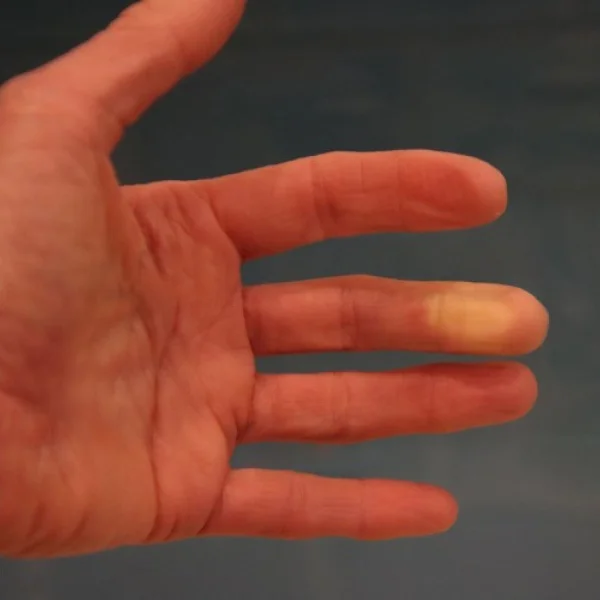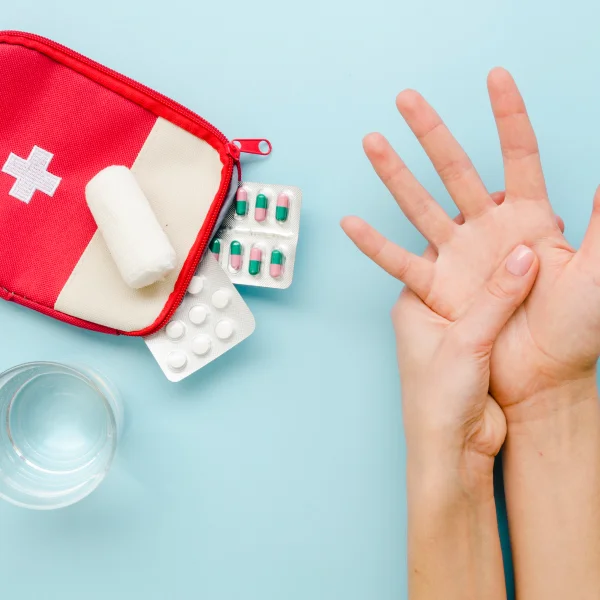Raynaud’s disease is a condition that disrupts blood circulation in the extremities, causing episodes of vasoconstriction that can make fingers and toes extremely vulnerable to cold and lack of oxygenation. At Totum Tech, we understand the importance of this issue for those living with this condition.
A question often arises: can Raynaud’s disease lead to gangrene? Does this risk truly exist, or is it just a misconception? In this article, we will examine the circumstances in which Raynaud’s disease could lead to necrosis and gangrene, as well as the essential precautions to prevent these complications.
What is raynaud’s disease and how does it affect blood circulation?
Raynaud’s disease is a condition that causes a temporary reduction in blood circulation to the extremities, typically fingers and toes. This phenomenon occurs in response to cold or stress, causing a color change in the extremities, going from white to blue, and then to red when blood flow returns.
There are two forms of Raynaud’s disease. Primary Raynaud’s is considered benign, as it has no identifiable underlying cause and its symptoms remain generally moderate. In contrast, Secondary Raynaud’s is associated with autoimmune diseases such as scleroderma, lupus, or rheumatoid arthritis, which can make it more severe.
When episodes become frequent and intense, they can gradually alter microcirculation, weaken tissues, and increase the risk of complications.
Can raynaud’s disease lead to gangrene?

The link between Raynaud’s disease and gangrene primarily depends on the severity of the circulatory disorder. In the majority of cases, this disease does not lead to permanent damage. However, in its secondary form or when not properly managed, it can promote serious complications, including tissue necrosis.
How does gangrene develop in raynaud’s disease?
Chronic poor circulation can severely affect the extremities by preventing oxygen and nutrients from properly reaching the tissues. This prolonged lack of irrigation weakens the skin and slows healing, which can lead to persistent wounds. Without appropriate care, these wounds risk becoming infected, further compromising tissue health.
When oxygenation becomes insufficient for a prolonged period, cell death can occur, leading to necrosis, which in advanced cases, can progress to gangrene. One of the most concerning signs is the appearance of black toes, a symptom that reflects extreme tissue suffering due to a critical lack of blood supply.
This manifestation must be taken very seriously, as it can signal a high risk of irreversible complications requiring urgent medical intervention.
What signs should you watch to avoid gangrene?
It is crucial to recognize precursor signs of a complication to act in time:
- Persistent sensation of intense cold in fingers and toes.
- Appearance of black toes or dark spots on the skin.
- Continuous pain, even in the absence of an episode.
- Presence of ulcers or wounds that are slow to heal.
If these symptoms appear, a quick medical consultation is essential to prevent progression towards necrosis and possible gangrene.
Raynaud’s syndrome treatment: how to avoid serious complications?

Adopting a proactive approach helps limit risks and preserve the health of your extremities.
Strategies to improve circulation and avoid gangrene
- Protection against cold: Wear thermal gloves and socks to avoid thermal shocks.
- Stress management: Practice relaxation to limit emotional triggers of episodes.
- Regular physical activity: Stimulates circulation and reduces the intensity of episodes.
- Advanced technological solutions: Solutions like those offered by Totum Tech help improve circulation and reduce necrosis risks.
Appropriate medical follow-up and the use of innovative solutions can play a key role in preventing complications of Raynaud’s disease.
Protect your extremities: prevent raynaud’s disease complications
Raynaud’s disease, when well managed, does not systematically lead to complications like gangrene. However, in severe or poorly managed cases, prolonged lack of tissue oxygenation can lead to necrosis, thus increasing the risk of gangrene. It is therefore essential to monitor symptom progression and adopt appropriate preventive measures.
If you want to better protect your extremities and avoid the harmful effects of poor circulation, discover Totum Tech’s solutions. Join our waiting list now and access the best technologies to preserve your well-being.




